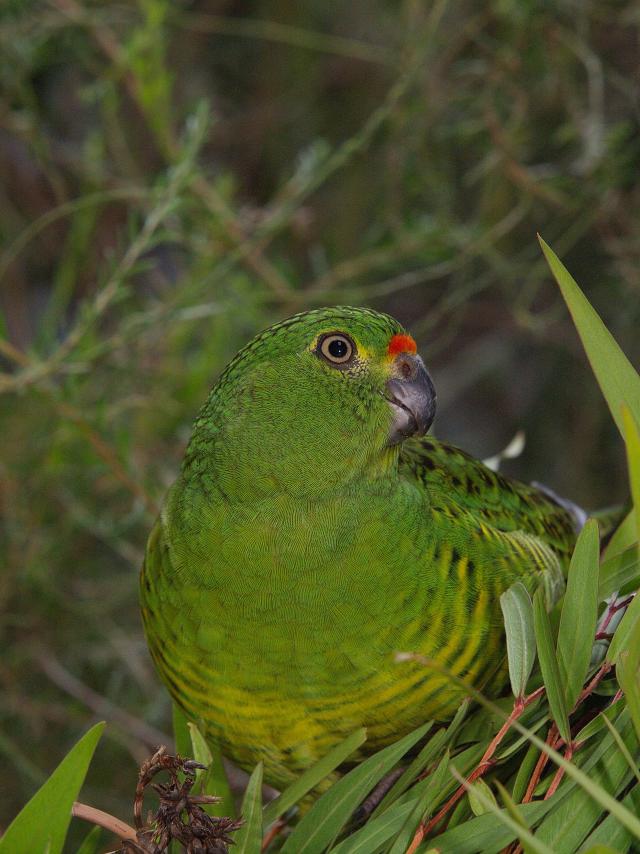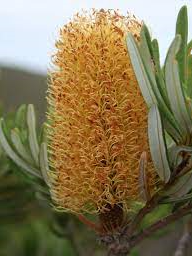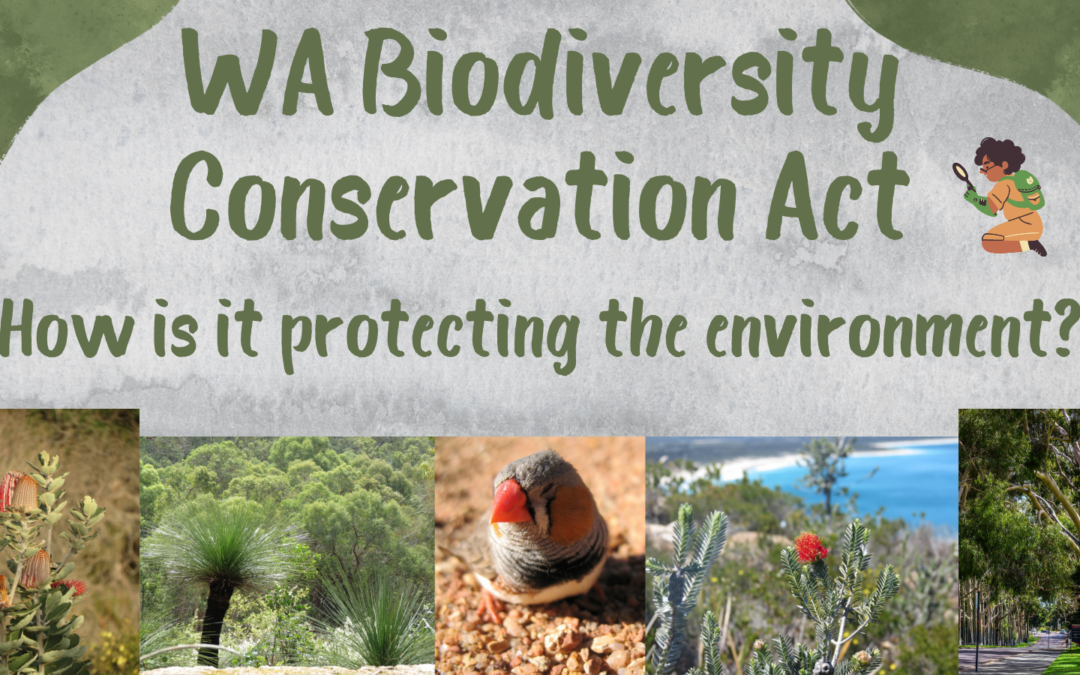Western Australia is renowned for its rich and diverse biodiversity, which holds significant cultural, environmental, and economic importance. It is home to an incredible number of endemic plants and animals – meaning many of the plants and animals occurring in WA only occur here. For instance, 80% of WA native plants are endemic (Beard, Chapman, & Gioia, 2000). Over the past 150 years, the state’s biodiversity has been subject to impacts from clearing, weeds, disease introduction, soil salinisation, and climate change. Consequently, many ecosystems have been adversely impacted, and some are on the edge of collapse. In 2019, the WA Biodiversity Conservation Act 2016 (BC Act) was enacted to limit impacts on the state’s remarkable biodiversity. The BC Act replaces the WA Wildlife Conservation Act 1950 and parts of the WA Sandalwood Act 1929.
The BC Act establishes a mechanism for protecting WA’s native plant and animal taxa. It enforces more robust protection of WA’s biodiversity and now includes provisions for ecological communities, critical habitats, threatening processes, environmental pests and introduced plant species. The BC Act provides a legislative framework for listing native species and ecological communities identified as under threat of extinction or collapse (DBCA, 2022). The Act is administrated by the Department of Biodiversity, Conservation and Attractions (DBCA). Within the DBCA, the Threatened Species and Ecological Communities branch protects and prohibits anyone from taking, disturbing or modifying without proper authorisation – and be careful, stricter penalties apply.
The BC Act also establishes greater responsibilities for land users involved in clearing or other activities that may impact threatened species and communities. As a land user, it’s important to be familiarised with the BC Act and its requirements. This Insight will provide an overview of the key aspects land users should know.
What does it mean to be ‘threatened’?
The conservation status of a species indicates its risk of extinction and, within WA, is determined based on the criteria established in Ministerial guidelines (DBCA, 2021a). When assigning a threat category to a species, DBCA assesses a range of factors, including the population size and trends, geographic range, and the severity of known threats. The BC Act assigns threat categories based on the ranking outlined in the internationally-recognised International Union for Conservation of Nature (IUCN) Red List of Threatened Species Categories and Criteria (2012). Threatened plants and animals may be classified as Critically Endangered, Endangered, Vulnerable, or Specially Protected (see Table 1) (DBCA, 2021a). Categorising species based on their conservation status is vital in prioritising scarce resources, influencing scientific research, and directing conservation policy and action (IUCN, 2022).
The Act defines an ecological community as ‘a naturally occurring biological assemblage that occurs in a particular type of habitat’. An ecological community becomes a ‘threatened ecological community’ when it falls under the following categories – ‘vulnerable’, ‘endangered’, ‘critically endangered’ or ‘presumed totally destroyed’ (the equivalent of a species being extinct) (see Table 1). To appropriately assign a threat category to a threatened ecological community, DBCA has regard to its geographic range, number of occurrences, degree of modification, vulnerability to threatening processes, and capacity for restoration or rehabilitation (DBCA, 2021b).
Table 1. Conservation Codes for Threatened Species in WA under the Biodiversity Conservation Act 2016.

The listing of a threatened species or ecological community begins with a nomination. The Act invites anyone from the general public to nominate a native species or ecological community to be listed, delisted, or its status amended on existing lists. Every year, the state’s Threatened Species Scientific Committee (TSSC) and Threatened Ecological Communities Scientific Committee (TECSC) meet to consider the nominations and propose recommendations to the Minister for Environment. Once the Minister reviews, any amendments will be published in the Western Australian Government Gazette, and the nominator will be informed of the outcome (DBCA, 2018a). DBCA presents a final list of threatened animals, plants and ecological communities on their website. The Act now also allows public nominations of threatening processes to become a ‘key threatening process’ following the same process as listing a threatened species or ecological community (DBCA, 2023b).
Licensing and Authorisations
The BC Act protects and conserves WA’s biodiversity to a greater extent, and owing to this, landowners and developers have greater responsibility and face increased penalties. While the Wildlife Conservation Act 1950 prohibited the taking and disturbance of protected flora and fauna, the BC Act introduced the prohibition of modifying threatened ecological communities. To avoid confusion, the Act explicitly defines what it means to take, disturb or modify:
To take refers to killing, injuring, harvesting or capturing threatened fauna and gathering, plucking, cutting, pulling up, destroying, digging up, removing, harvesting or damaging threatened flora;
To disturb includes behaviours such as chasing, driving, following, harassing, herding or hunting threatened fauna and applying an identifier or altering the natural behaviour of threatened flora; and
To modify refers exclusively to threatened ecological communities and involves activities that alter species composition and/or structure to the degree of improbable recovery or destroy the threatened ecological community.

Native Fauna
A licence is required when taking, disturbing or possessing fauna. Fauna taking licences cover commercial purposes, scientific and educational purposes, biological assessments, and fauna relocation. Fauna disturbing licences apply to commercial interactions, non-commercial tours, scientific and educational purposes, or feeding or luring of fauna. These licenses should be obtained when land users are clearing native vegetation and must relocate fauna inhabiting their land. Fauna possessing licences are relevant when possessing fauna for education or conservation purposes or when displaying, breeding, rehabilitating or keeping fauna as pets. If a threatened or specially protected species becomes under your temporary possession (i.e., due to injury, disease or abandonment etc.), DBCA must be notified within 24 hours. The formal method for this is to complete and submit an Injured or Abandoned Fauna Notification form, including contact information, species information, where the animal was found, the reason the animal was taken in, and a strategy for care and release. Possessing a native animal without an appropriate licence or authorisation may result in an infringement fine of $2,500 or a penalty between $50,000 to $500,000, depending on the conservation status of the animal (DBCA, 2018b).
Native Flora
All native flora (e.g., flowers, seeds, whole plants, timber and firewood) is protected under BC Act. Restrictions also apply for clearing native vegetation; however, these permits are regulated under the Environmental Protection Act 1986. The BC Act is responsible for licencing where native flora is taken on private, Crown or CALM Act lands (DBCA, 2018c). However, if the native flora is threatened, then a Threatened Flora Authorisation is required from the Minister. This Authorisation permits the collection of a threatened plant (including its cuttings or seeds). Certain circumstances require native/threatened flora to be taken or disturbed, such as land clearing, mining activities, road maintenance, or scientific research (e.g., taking herbarium specimens for identification purposes or taxonomic research) (DBCA, 2014). In these circumstances, an appropriate licence or authorisation must be issued. Otherwise, penalties apply (such as $500,000 for taking threatened flora).
Ecological Communities
Ministerial authorisation must be obtained if planning to modify a threatened ecological community. Land users should consider impacts that have the potential to, directly and indirectly, affect an ecological community (i.e., sectors that tend to have ‘significant’ actions). For instance, wetlands are an essential ecological community sensitive to water resource changes, so they may be adversely impacted if water were to be extracted, altered, or diverted as part of a proposal (DBCA, 2019). An application for this authorisation should be lodged with DBCA and cover the basis of the proposal, the extent of the threatened ecological community, and the potential impacts (DBCA, 2018d). Conditions may apply if authorisation is, in fact, granted. This could include guidelines on how to perform the proposed actions or mitigate any impacts on the occurrence of the threatened ecological community. Unauthorised modification of a threatened ecological community faces penalties of up to $500,000.
Notification on Title
Provided by the Minister, Notification on Title refers to a written notice given to a land user to the presence of a threatened species, threatened ecological community, or critical habitat. Within this document, the Minister specifies and locates what threatened value or critical habitat is present and offers support and advice to facilitate its management under current legislation. Once a Notification of Title has been lodged, the land user must inform their visitors of the presence of a threatened species, threatened ecological community or critical habitat on their land. The land user must also notify any changes in ownership or occupancy to DBCA (DBCA, 2016). Non-compliance from the land user can involve a fine of $20,000.
Biodiversity Management Programmes
The BC Act now includes provisions for Biodiversity Management Programmes – a document addressing the conservation, protection and management of native species, ecological communities, or critical habitats. The Minister approves these programmes, which are essential when managing the ecologically sustainable use of natural resources, biodiversity conservation research and actions, nature-based tourism, and educational activities. Biodiversity Management Programmes aren’t considered subsidiary legislation but supportive documents that explain conservation management objectives in great detail (DBCA, 2016). Recently, DBCA drafted their first Sandalwood (Santalum spicatum) Biodiversity Management Programme following the criteria outlined within the BC Act. This document addresses how native sandalwood populations should be conserved, managed and used sustainably (DBCA, 2023a).

Recovery Plans
Recovery plans provide research and management actions to guide the ‘recovery’ of a threatened species or ecological community to a healthy level. They are developed on a priority basis, prioritising species or ecological communities most at risk. Recovery plans outline the objectives to facilitate recovery and provide advice and/or methods to control key threatening processes. They are reviewed regularly (within a 10-year interval) to ensure effective conservation management strategies (DBCA, 2023c). State recovery plans are publicly available on the DBCA threatened animals, plants and ecological communities website.
Biodiversity Conservation Agreements and Covenants
A biodiversity conservation agreement works between the Minister and the land owner or occupier to coordinate biodiversity conservation activities on private or Crown land. Establishing this type of collaboration with private land users enhances the protection and conservation of biodiversity. Under the Act, private land users have greater security for their cooperation. Sometimes, the Minister may even supply financial assistance, resources or technical expertise to meet conservation management objectives (DBCA, 2016).
Alternatively, a biodiversity conservation covenant can be established to permanently protect biodiversity conservation efforts on private land or for a long-term duration. These covenants include positive and restrictive condition-making (i.e., a specific set of actions to protect and, if possible, enhance the existing habitat that needs to be adhered to). Registered on the Land title protects a biodiversity conservation covenant is protected by Registered on the Land title so non-compliance will carry a $50,000 penalty (DBCA, 2016).
Successful biodiversity management requires the efforts of private land users and government bodies. Our team at Integrate Sustainability have a solid knowledge base of environmental legislation and compliance requirements. If you want to know more about the WA Biodiversity Conservation Act 2016 and your responsibility under the Act, please call (08 9468 0338) or email us at enquiries@integratesustainability.com.au.
References
Beard, J., Chapman, A., & Gioia, P. (2000). Species richness and endemism in the Western Australian flora. Journal of Biogeography, 1257-1268.
DBCA. (2014). Authorisation to take threatened plants – Department of Biodiversity, Conservation and Attractions. Retrieved from https://www.dpaw.wa.gov.au/plants-and-animals/threatened-species-and-communities/threatened-plants/200-authorisation-to-take-threatened-plants
DBCA. (2016). Major differences between the Biodiversity Conservation Act 2016 and the Wildlife Conservation Act 1950 (and, as relevant, the Sandalwood Act 1929) by Department of Biodiversity, Conservation and Attractions.
DBCA. (2018a). Ministerial Guideline No. 1 – Procedures for making and assessing public nominations for listing species and communities as threatened species or threatened ecological communities, and for listing key threatening processes (Department of Biodiversity, Con.
DBCA. (2018b). Licences and Authorities – Fauna licences (Department of Biodiversity, Conservation and Attractions). Retrieved from https://www.dpaw.wa.gov.au/plants-and-animals/licences-and-authorities?showall=&start=4
DBCA. (2018c). Licences and Authorities – Flora licences (Department of Biodiversity, Conservation and Attractions). Retrieved from https://www.dpaw.wa.gov.au/plants-and-animals/licences-and-authorities?showall=&start=1
DBCA. (2018d). Licenses and Authorities – Authorisation to modify a threatened ecological community (Department of Biodiversity, Conservation and Attractions). Retrieved from https://www.dpaw.wa.gov.au/plants-and-animals/licences-and-authorities?showall=&start=5
DBCA. (2019). Guidance note – Modification of an occurrence of a threatened ecological community by Department of Biodiversity Conservation & Attractions.
DBCA. (2021a). Ministerial Guideline No. 2 – Threatened and extinct species listing specifications and criteria (Department of Biodiversity, Conservation and Attractions).
DBCA. (2021b). Ministerial Guideline No. 4 – Threatened ecological communities listing specifications and criteria (Department of Biodiversity, Conservation and Attractions).
DBCA. (2022). Biodiversity Conservation Act and Regulations – Department of Biodiversity, Conservation and Attractions. Retrieved from https://www.dbca.wa.gov.au/biodiversity-conservation-act
DBCA. (2023a). Draft Sandalwood Biodiversity Management Programme. Retrieved from https://www.dbca.wa.gov.au/draft-sandalwood-biodiversity-management-programme
DBCA. (2023b). Nominations for listing (and delisting) of threatened plants, animals and ecological communities – Department of Biodiversity, Conservation and Attractions. Retrieved from https://www.dpaw.wa.gov.au/plants-and-animals/threatened-species-and-communities/118-call-for-public-nominations-for-listing-and-delisting-of-threatened-plants-and-animals
DBCA. (2023c). Threatened species and communities (Department of Biodiversity, Conservation and Attractions). Retrieved from https://www.dpaw.wa.gov.au/plants-and-animals/threatened-species-and-communities
International Union for Conservation of Nature. (2012). IUCN Red List categories and criteria (Version 3.1).
IUCN. (2022). How the Red List is used. Retrieved from https://www.iucnredlist.org/about/uses

